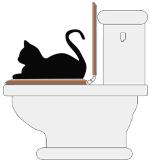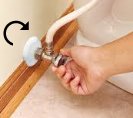❈ How To: Replace a Toilet
 Step-by-Step Tutorial
Step-by-Step Tutorial
Toilets seem so permanent. But replacing one is actually not that big a deal, requiring only modest plumbing skills and a few basic tools. Moreover, a new toilet will dramatically dress up your bathroom and decrease the amount of water required for each flush. Older toilets used up to 7 or 8 gallons per flush, while today's toilets use 1.6 gallons.
Tools Needed:▸ Adjustable pliers▸ Screwdriver ▸ Adjustable wrench ▸ Edge scraper ▸ Bucket ▸ Sponge ▸ Gloves |
Materials Needed:▸ Silicone caulk▸ Wax ring ▸ Closet bolts ▸ Flexible supply tube ▸ Toilet seat © Sierra On-Line, Inc. |

Do It Yourself or Hire a Pro?A plumbing contractor will charge about $350 to remove an old toilet and replace it with a new one; you can buy a new toilet and materials for about $180. With some plumbing experience, most homeowners can replace a toilet, but it requires heavy lifting and there's some risk of breakage. If the floor around the toilet is springy, there may be wood decay in the flooring and subfloor under the toilet, which makes for a much more complicated task. You'll have to cut out the rotten wood and replace it before you can install the toilet. In that case, you may want to hire a contractor to do the job. Rot repair extends the job to a day or more.Before you plan any plumbing job, check with your local building inspector to make sure that you know the code requirements. Also check with your local utility for any rebate programs on low-flush toilets. If you plan to redecorate the walls or replace the floor in the bathroom, do so before you install the new toilet. It's easier to work without the toilet in place. Painting around a toilet is as much fun as it sounds. |
|
Step by Step Instructions |
|
1. Turn off the water supply.Shut off the water at the angle stop, the wall valve that controls the water supply at the base of the toilet. Turning the valve clockwise will turn off the water. Flush the toilet and use a small bucket as a dipper to remove water from the tank and bowl, then use a large sponge to finish. |
|
2. Disconnect the water supply tube.Use an adjustable wrench to disconnect the supply tube from the angle stop and the toilet tank. |
|
3. Unscrew the closet bolts.Remove the plastic or ceramic caps at the toilet base to reveal the closet bolt nuts. Loosen and remove these with an adjustable wrench. |
|
 Tip from the pros: If the caps don't come off, squeeze them with adjustable pliers until they break. If a nut does not loosen, apply penetrating oil. If that fails, use a hacksaw to cut through the closet bolt, beneath or through the nut. Tip from the pros: If the caps don't come off, squeeze them with adjustable pliers until they break. If a nut does not loosen, apply penetrating oil. If that fails, use a hacksaw to cut through the closet bolt, beneath or through the nut. |
|
4. Remove the old toilet.With a helper, rock the toilet slightly to break the old wax seal. Then lift the toilet off the closet bolts and, with your helper, carry the toilet out. Plug the drain hole in the floor with a large rag or wad of newspaper. Don't use something so small that it could fall down the waste pipe. |
|
5. Remove the closet bolts and old wax.Remove the old closet bolts from the closet flange. Use a putty knife to scrape old wax from the closet flange. |
|
6. Install the closet bolts and wax ring.Place new closet bolts in the exact positions of the old bolts. Hold them in place with a little of the old wax ring material around their heads. Place a new wax ring over the closet flange.7. Connect the tank to the toilet bowl.If you bought a two-piece toilet, position the tank over the water inlet on the back of the bowl. Put the rubber washers on the tank bolts and insert the bolts in the tank holes and through the matching holes on the bowl. Attach the washers and bolts and tighten them with your adjustable wrench. |
|
8. Attach the toilet.Put plumber's putty on the toilet base. Remove the rag or wadded-up newspaper from the drain. Then turn the toilet rightside-up and lower it onto the closet bolts. Press it down firmly, then sit on the toilet to seat it and its wax ring on the closet flange. Place washers and nuts on the closet bolts and tighten the nuts carefully. |
 |
|
|
9. Reconnect the water supply.Replace the supply tube with new flexible tubing. Open the angle stop and test the toilet. Make sure there are no leaks at the base when you flush. Place silicone caulk around the toilet base to keep out water and dirt. Use a hacksaw to trim the closet bolts, and replace the bolt caps. |
|
 Tip from the pros: If the toilet base leaks and the closet bolts are loose, you may be able to cure the leak just by tightening the bolts. Turn them by hand until tight, then use a wrench for a final half-turn. Tip from the pros: If the toilet base leaks and the closet bolts are loose, you may be able to cure the leak just by tightening the bolts. Turn them by hand until tight, then use a wrench for a final half-turn. |
|
Hire a ProAll licensed plumbing contractors are plumbers, but not all plumbers are licensed. A plumbing contractor can have unlicensed plumbers working under his or her license. A licensed plumbing contractor is responsible for the workmanship and quality of his or her workers. You can save some money by hiring an unlicensed plumber, but you won't have much recourse if his or her work is unsatisfactory.Include these points in any written contract with a plumber:
|
|
Design TipsBefore you shop for toilets, measure the distance from the wall to the closet bolts of the existing toilet to determine if it's a 12'' or 14'' offset.The color selection and styles of toilets can be mind-numbing. Spend some time walking through a bathroom showroom or display to get an idea of the colors and styles. Narrow your preferences before you talk with a plumber, and you'll get a more accurate estimate. And remember, white fixtures always cost considerably less than colored ones. There are two basic types of toilets: ▸ A one-piece fixture constructed as one unit with a tank and bowl ▸ A two-piece unit with a separate water tank and bowl Two-piece units are more popular and less expensive than one-piece toilets. If you buy a new toilet, it will come with a flush mechanism inside the tank. The most popular flush mechanism is a gravity-fed flush unit that uses the force of gravity and a siphoning, pull-through action to empty the bowl. Put more simply: The water in the tank drops into the bowl (whoosh!) and drives waste down the drain pipe. The other type, a pressure-assisted toilet, relies on either compressed air or a water pump to boost the flushing power. |
|
🌵 Search azWoodman






